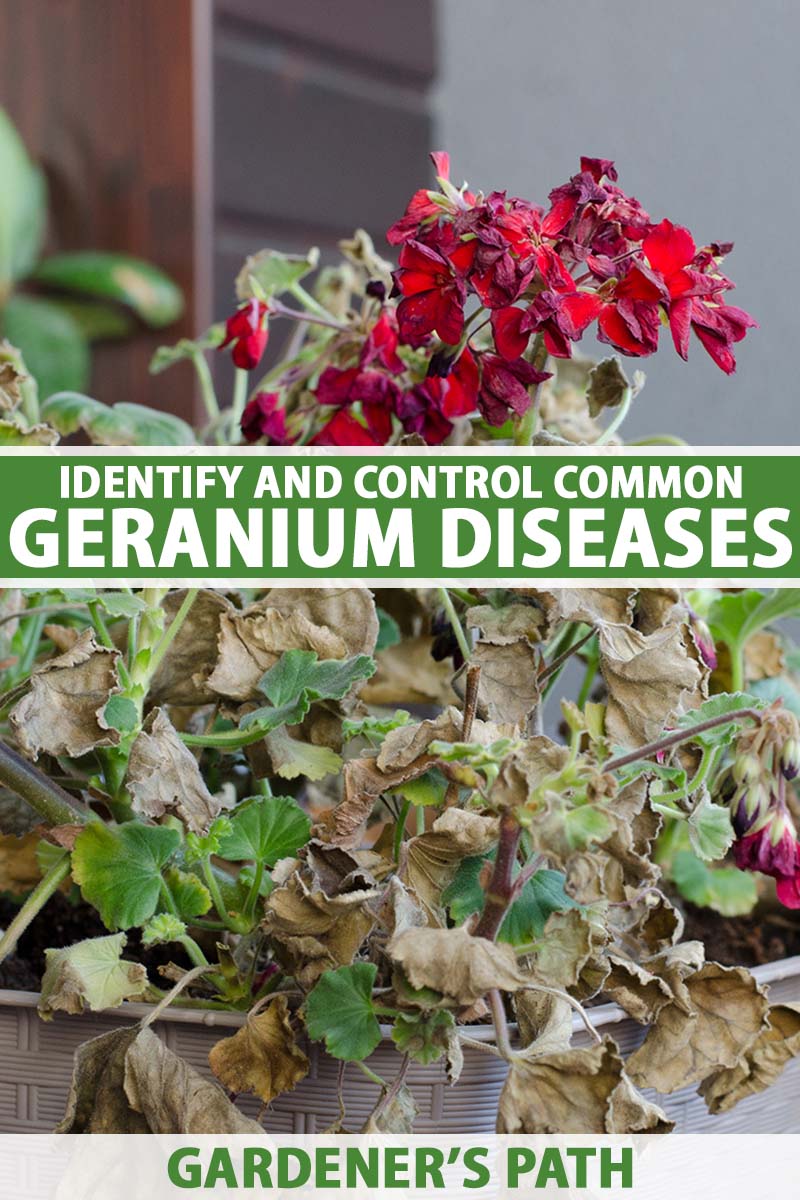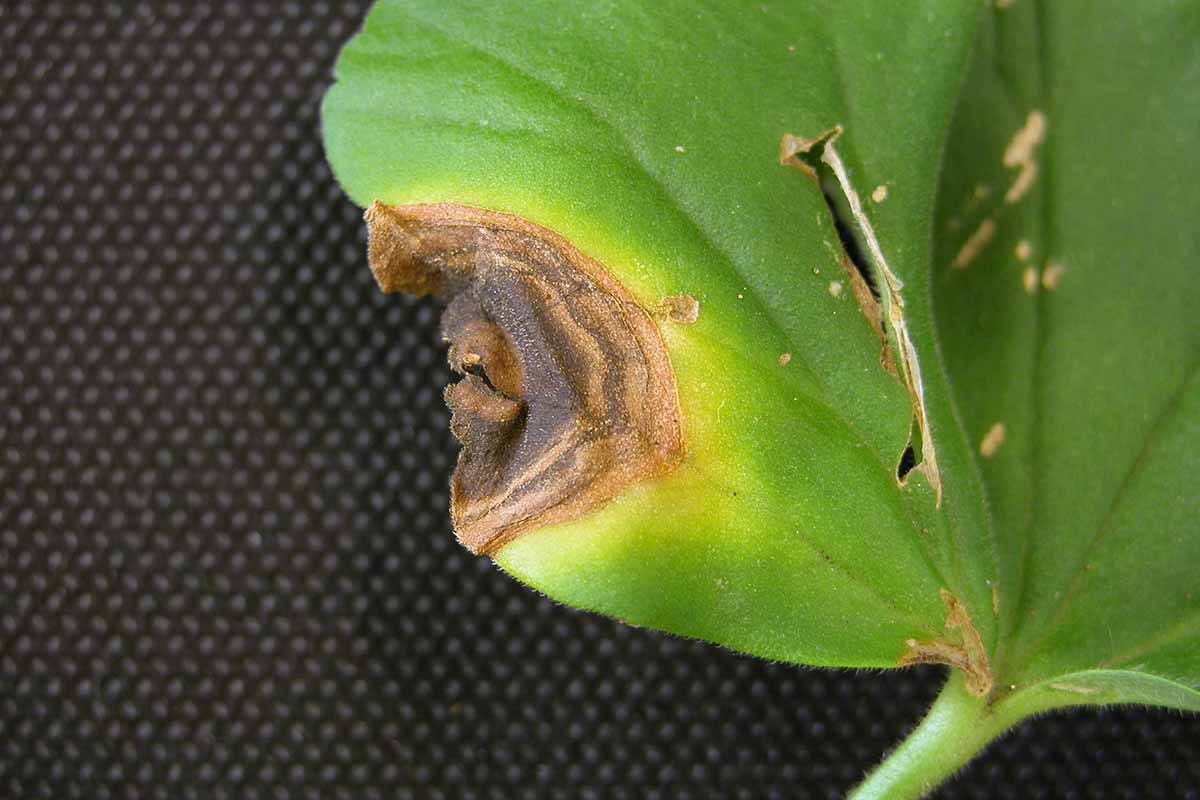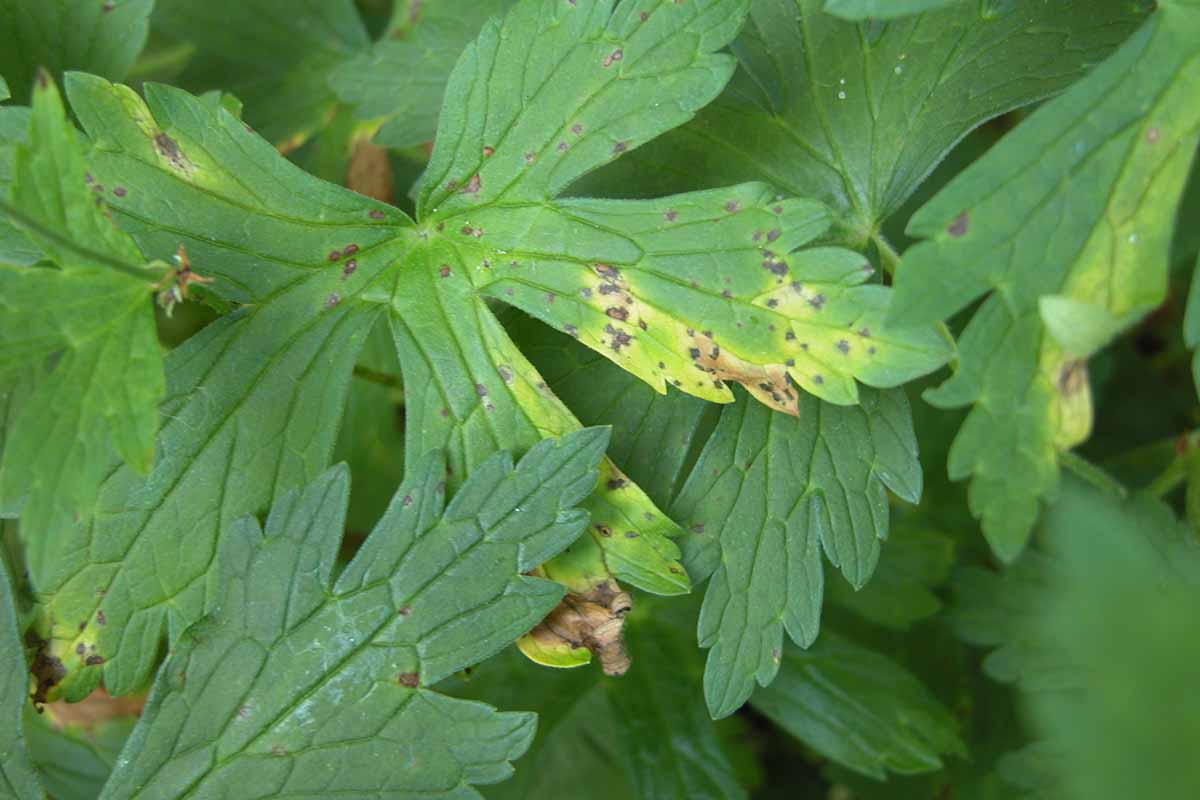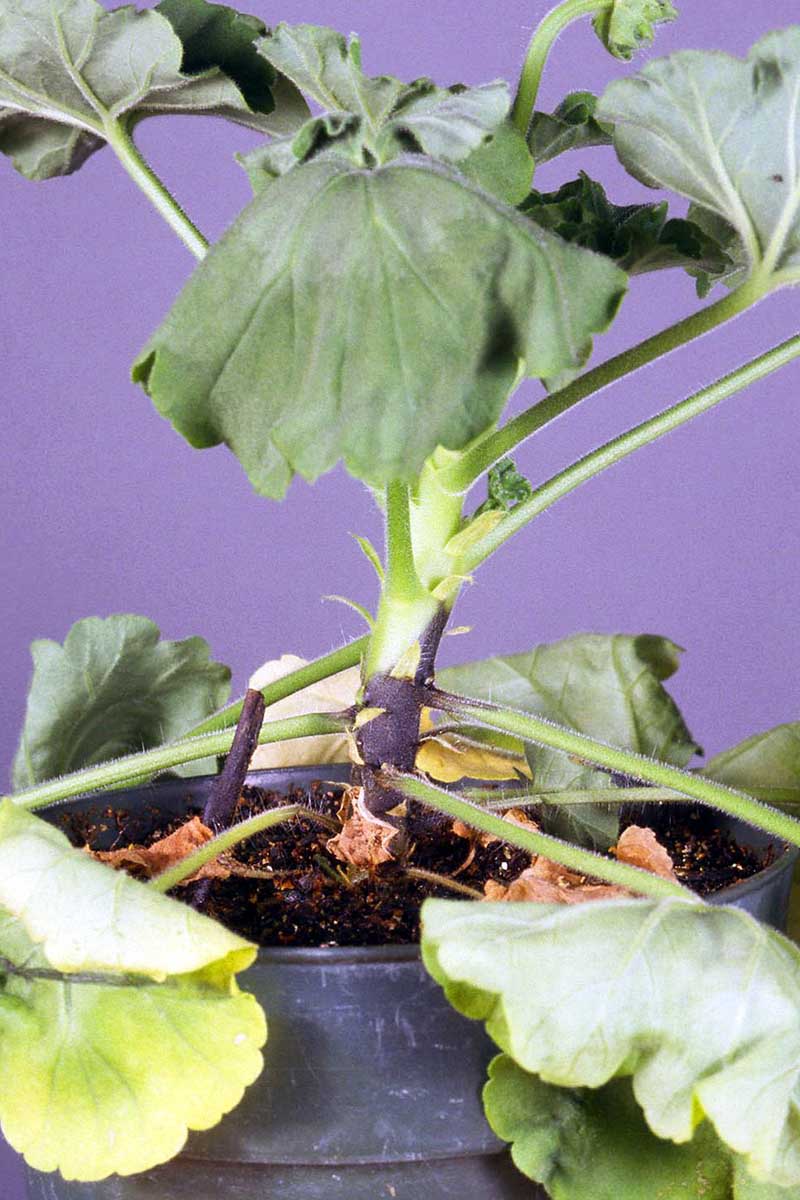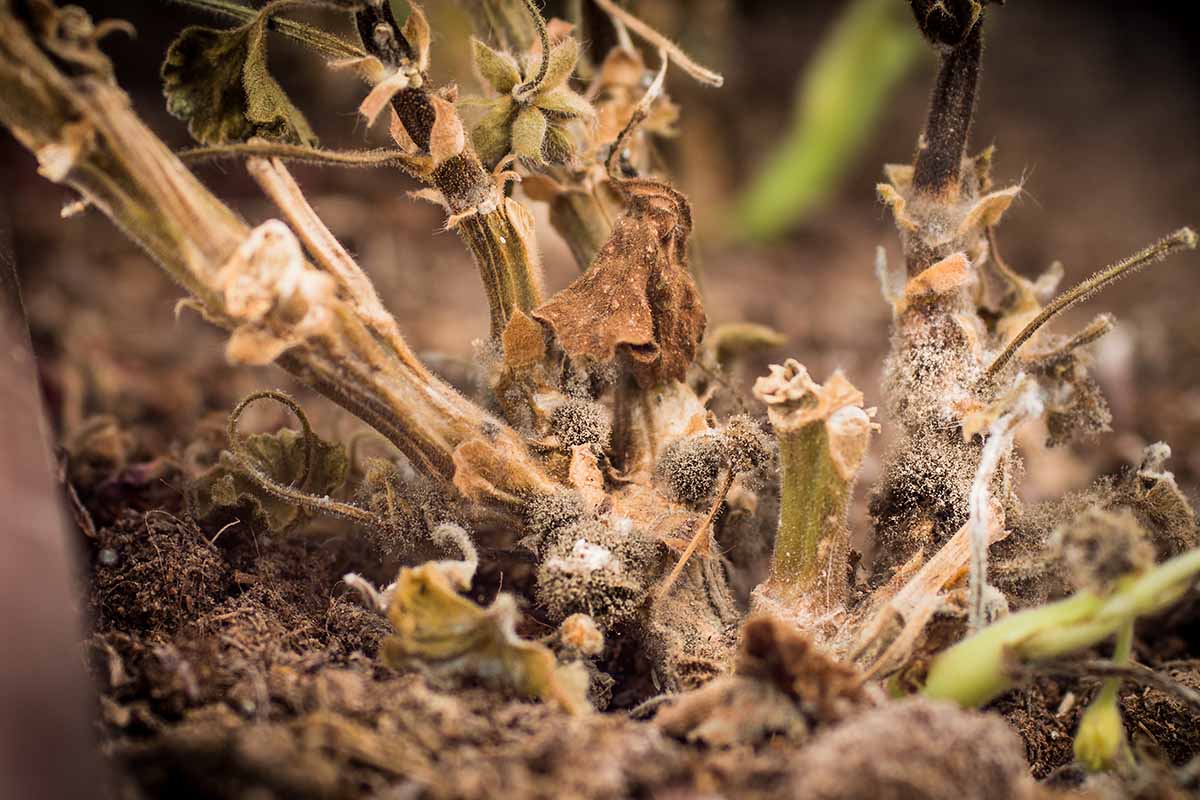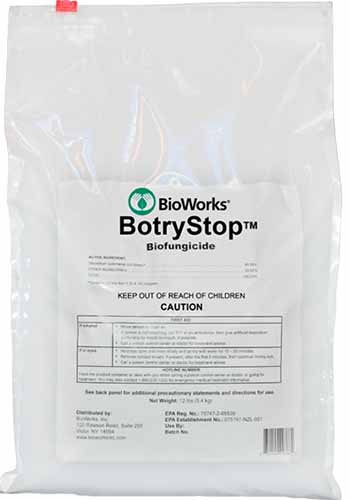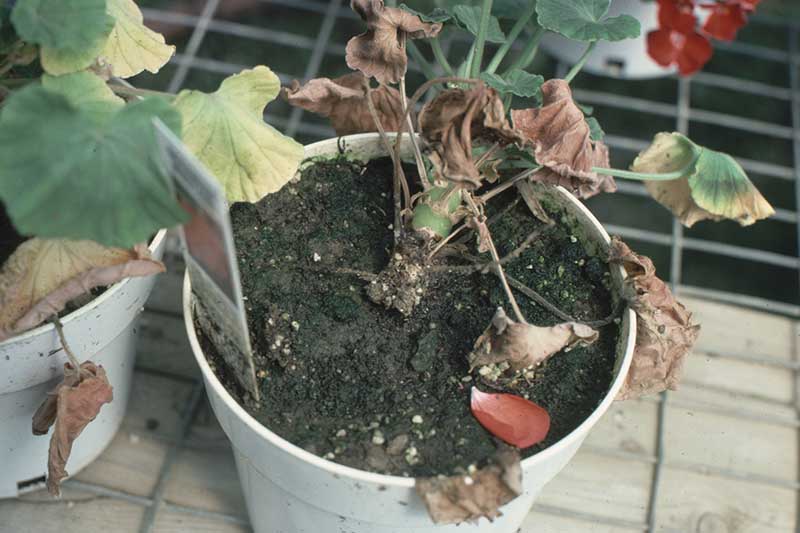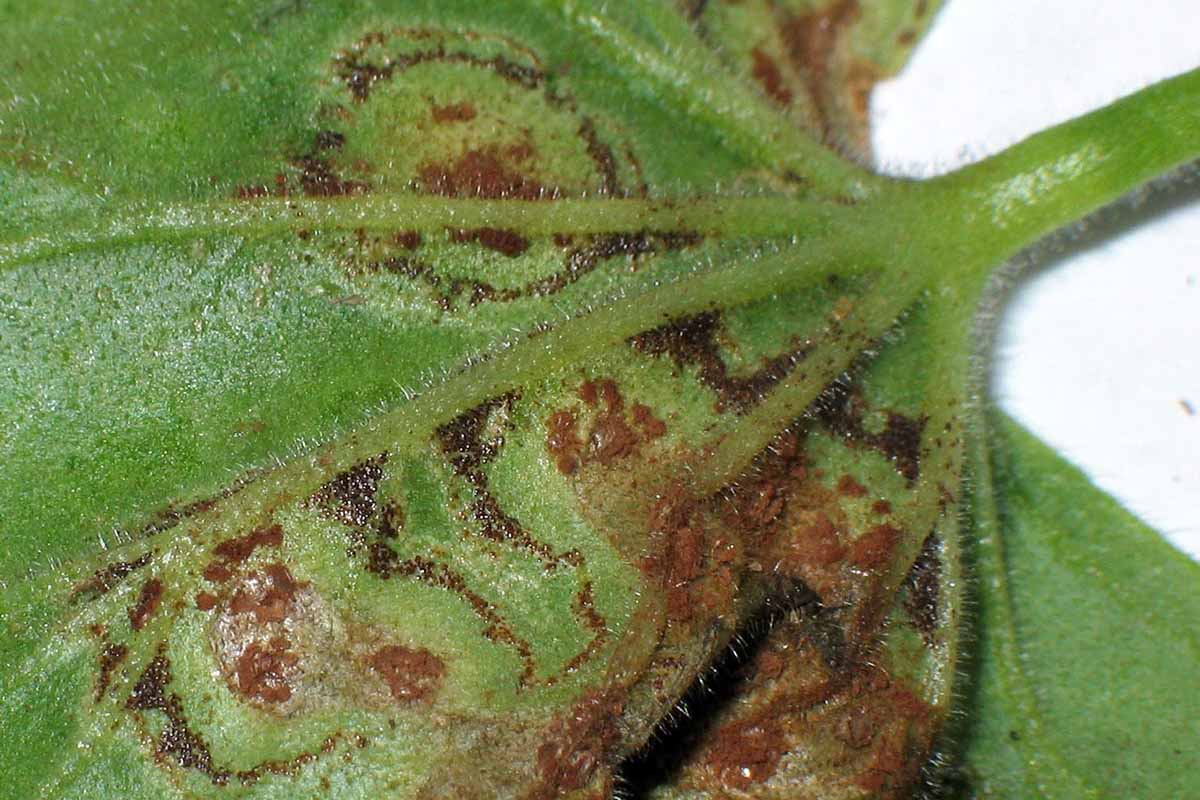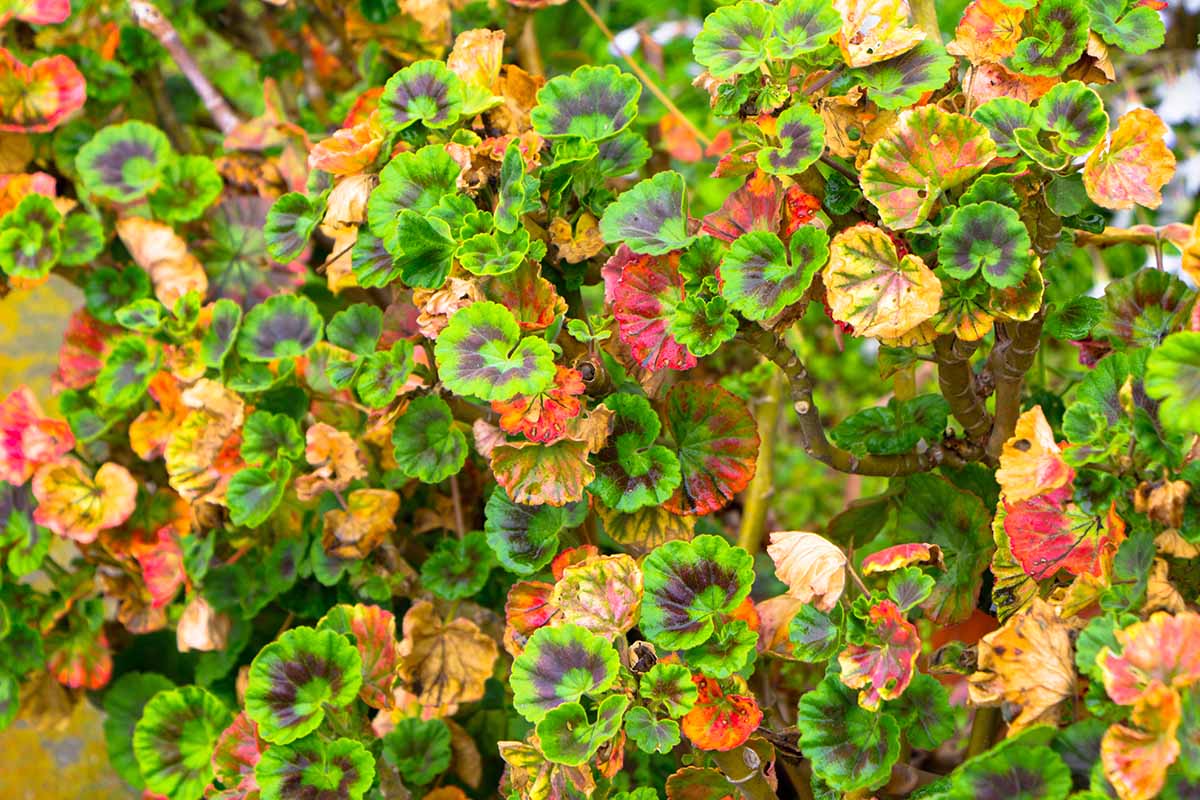Those mounds of green leaves are smothered by bright, cheerful blossoms all summer long, and it’s enough to lift anyone’s spirits. But the plants themselves seem to be pretty happy, too, judging by the fact that they so rarely seem to have problems. We link to vendors to help you find relevant products. If you buy from one of our links, we may earn a commission. Coming up, we’re going to look at nine different diseases that can cause problems with geraniums. Many are easily addressed, but a few can spell disaster if they take hold. Either way, we aim to help you identify the issue and address it as best as possible. Here are the diseases to watch for: If you’re noticing yellow leaves, spots, or some suspicious-looking fuzz, you’re probably eager to figure out what the heck is causing it, so let’s not dally.
1. Alternaria Leaf Spot
If you examine the lower surface of the leaves and notice raised quarter- to half-inch water-soaked spots, it’s time to suspect Alternaria leaf spot. Caused by the fungus Alternaria alternata, it usually starts on the lower leaves before moving up to the higher ones. When the humidity is high, these spots will develop a fuzzy brown texture.
2. Bacterial Blight
Bacterial blight is bad news. It causes small sunken spots on the underside of the leaves, and the leaves may eventually wilt while the stem stays firm. Once the disease has developed, the best solution is to spray the plant every few weeks with a copper-based fungicide. Bonide Liquid Copper Fungicide I like Bonide’s Liquid Copper fungicide – you can grab some at Arbico Organics in 32-ounce ready-to-use, 16- or 32-ounce hose end, or 16-ounce concentrate containers. But any old liquid copper fungicide will do. Just follow the manufacturer’s directions for application and apply every two weeks as long as symptoms are present. Symptoms usually first appear on the lower leaves, and these leaves will turn grayish-brown and die off. This disease is caused by the bacteria Xanthomonas campestris pv. pelargonii. Once the plant is impacted, there is no cure. To avoid it, wash your garden tools, water at the soil level, and purchase plants that look healthy and show no signs of disease. This will help to prevent introducing the bacteria into your garden or spreading it if it’s present. Fortunately, this pathogen only attacks geraniums so you don’t need to worry about it spreading to or from other types of plants in the garden.
3. Blackleg
Water molds in the Pythium genus cause a disease commonly known as blackleg. It impacts a wide range of plants, including our lovely geraniums. You usually see it in propagated cuttings but it can happen at any point, and it can spell disaster pretty quickly. At first, the base of the seedling stem turns brown and appears wet. Then, the rot turns black and extends up the stem three or four inches. At that point, your geranium is toast. On older plants, the rot may start underground in the roots, but the result is the same. The bad news is that it ruins your pretty display until you can resolve the problem. If you catch it early, before the stem is entirely girdled, you can stop blackleg in its tracks. Mycostop biofungicide is extremely effective. It contains the beneficial bacteria Streptomyces Strain K61. Mycostop Biofungicide You can grab five or 25 grams of this stuff to keep on hand at Arbico Organics. Follow the manufacturer’s directions for treating the problem.
4. Botrytis Blight
Botrytis blight, caused by the fungus Botrytis cinerea, impacts the flowers first – which is both good and bad news. It’s good because this means you can usually spot it and start treating your plants quickly. The flowers are the main reason we keep geraniums in our gardens after all, right? We tend to look at them a lot more than we do the leaves! The flowers on your geraniums will turn brown and fall from the plant. The challenge is figuring out if the flowers are infected or if they are simply spent. An easy way to tell is to look at any place where a petal has landed on a leaf. You’ll see a yellow or brown spot form, with irregular margins. If that symptom is present, you can be sure botrytis has paid your garden a visit. The fungus that causes this disease is just waiting for you to make some sort of hole in the plant so it can sneak in. That means it’s important to try not to damage your geraniums at all, whether that is from accidentally hitting it with the edger, via hail damage, or if your dog (theoretically) steps on one. Not that that has ever happened to me, of course. That also means you really, really want to avoid pest problems. Every time an aphid or cabbage looper takes a chomp out of a leaf, that’s leaving the plant exposed. You should also snip off any damaged or dying leaves and any spent flower heads right away. Good spacing and air circulation also help to prevent Botrytis blight.
5. Fasciation
Fasciation (am I the only one whose brain wants to convert that word to “fascination?”) is caused by a bacterial pathogen known as Rhodococcus fascians. There is even a biofungicide available made using the beneficial fungus Unocladium oudemansii (U3 strain) that is extremely effective for putting an end to this infection. BotryStop Biofungicide If you decide to go this route, you can purchase a six- or 12-pound bag of BotryStop at Arbico Organics. It’s nice to have on hand because it can kill a number of different fungal pathogens. Just don’t forget to rotate in a copper fungicide or something else every few weeks until symptoms subside. It causes leafy galls, which is also another name for the disease. This is the growth of short, stumpy, bunched-up foliage which forms at the base of what otherwise looks like a normal geranium plant. If you spot this problem, you don’t need to remove your plants from the garden. But don’t use them to propagate new geraniums, and don’t overwinter the plants for growing next year. You don’t want to pass the disease on to future geranium plants, but it won’t spread to other species in your garden.
6. Pseudomonas Leaf Spot
Pseudomonas leaf spot can mimic many other diseases because it manifests in small, quarter-inch irregular spots with a dark center. The spots may have a yellow halo around them, but don’t rely on this as a marker because it may or may not be present. The spots can eventually merge together and kill off the leaf. The bacteria that causes the disease, Pseudomonas cichorii, infects many different species. And it can spread rapidly through a garden via water. Rain or irrigation splashing, or even water droplets in the air from humidity, can spread this pathogen. That’s why good spacing and watering at the soil level rather than from overhead on the foliage is so important. You should also water in the morning so the leaves can dry quickly in the afternoon sun and heat. It can also be spread by insects, which is why you need to do your best to keep your garden pest-free. Once the disease takes hold, trim away any infected leaves and treat your geraniums with a copper fungicide.
7. Root Rot
Root rot can be caused by two things. The first is simply watering too much. This deprives the roots of oxygen and they die off. The second is fungi in the Pythium genus (see blackleg above). Both cause the roots of the geranium to turn dark brown or black and mushy. Once the roots die off, the upper parts of the plant rapidly follow. It can be hard to tell what’s going on because the real action is all happening underground. Above ground, you might see wilting, stunting, or no new growth, and flowers that just generally look sad. The only way to tell what’s going on is to dig up your geranium and look at the roots. It’s pretty hard to tell whether the cause is overwatering or a fungus, so it’s best to just treat for both. Reduce watering and make sure you aren’t adding water until the soil has dried out an inch deep. Then, use Mycostop as described above for treating blackleg.
8. Rust
Rust was well-named because it looks just like it sounds like it would. On the top of the leaf, you’ll see yellow spots, but if you lift the leaf up and look underneath, you can see rust-colored spores. Rust is a common disease that impacts many different plants, but the fungus that specifically attacks geraniums is Puccinia pelargonii-zonalis. Remember how we mentioned that copper fungicide is your friend? Once again, it comes in handy here. Use it every few weeks for as long as symptoms are present, and then keep using it for a few weeks more.
9. Verticillium Wilt
If you imagined that a disease with “wilt” in the name would result in wilting leaves, you’d be right. Verticillium wilt can look a lot like bacterial blight because the plant simply turns brown and collapses. However, you won’t see the spots that can sometimes be present with blight. Instead of being caused by bacteria, this disease is caused by a fungus – either Verticillium albo-atrum or V. dahliae. Usually, by the time you see symptoms, the disease is well advanced. Look for triangular yellow wedges forming at the base of the leaves, followed by defoliation and collapse. There’s no effective way to treat it, so avoid Verticillium wilt in the first place by seeking out resistant cultivars (they’re common!), rotating where you plant geraniums every two or three years, and solarizing the soil between planting. If you do start to see weird growths, funny spots, or yellow leaves, we hope this guide helped set you on the right path. What was causing your pelargonium woes? How did you deal with it? Fill us in down below in the comments. And feel free to share if you have any questions! If you’re eager to continue your geranium growing adventures, we’d love to help out. And we have a handful of other helpful guides you might find interesting. Check these out next:
How to Plant and Grow Scented GeraniumsHow to Propagate Geraniums from Stem Cuttings15 of the Best Scented Geranium Varieties
